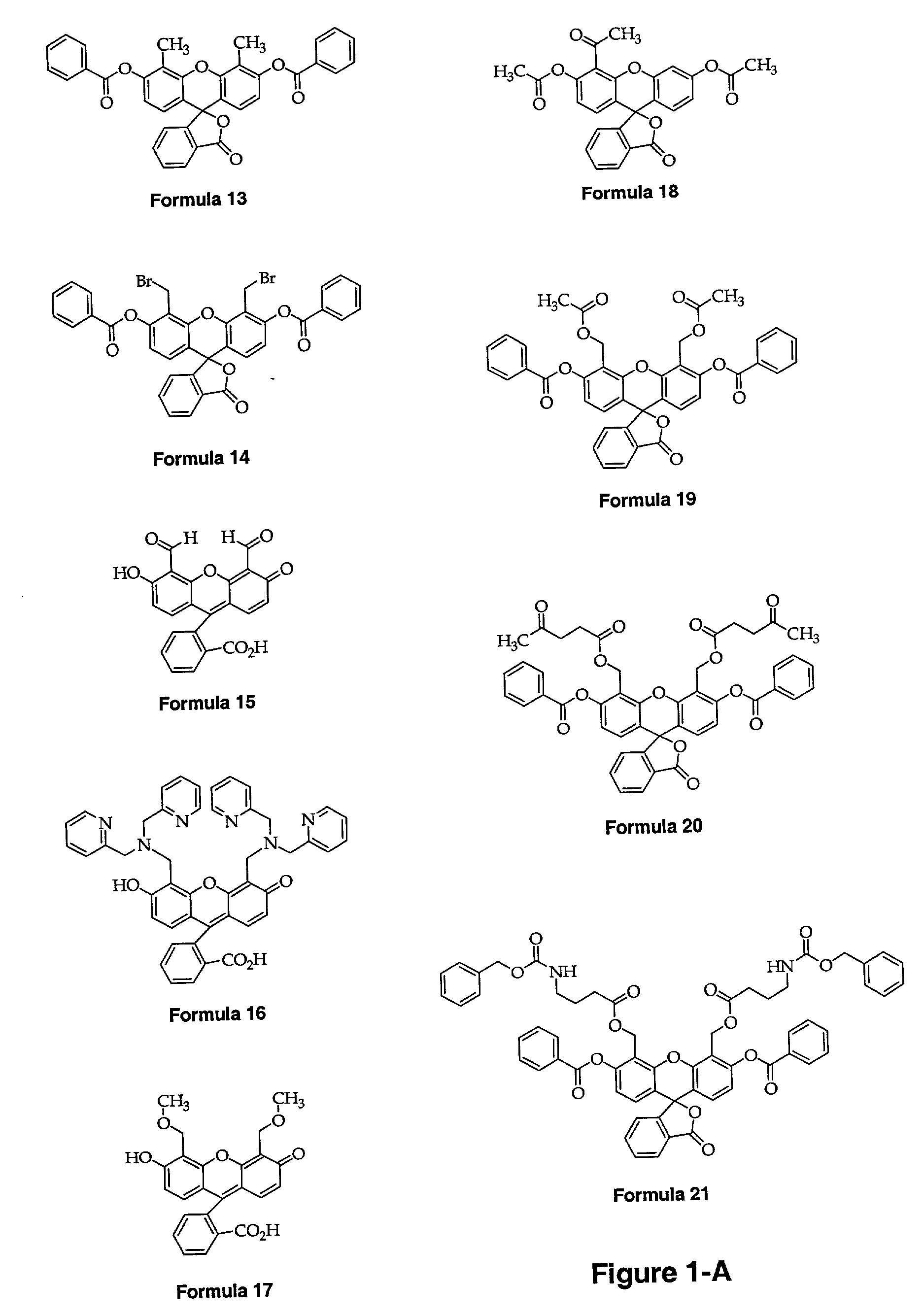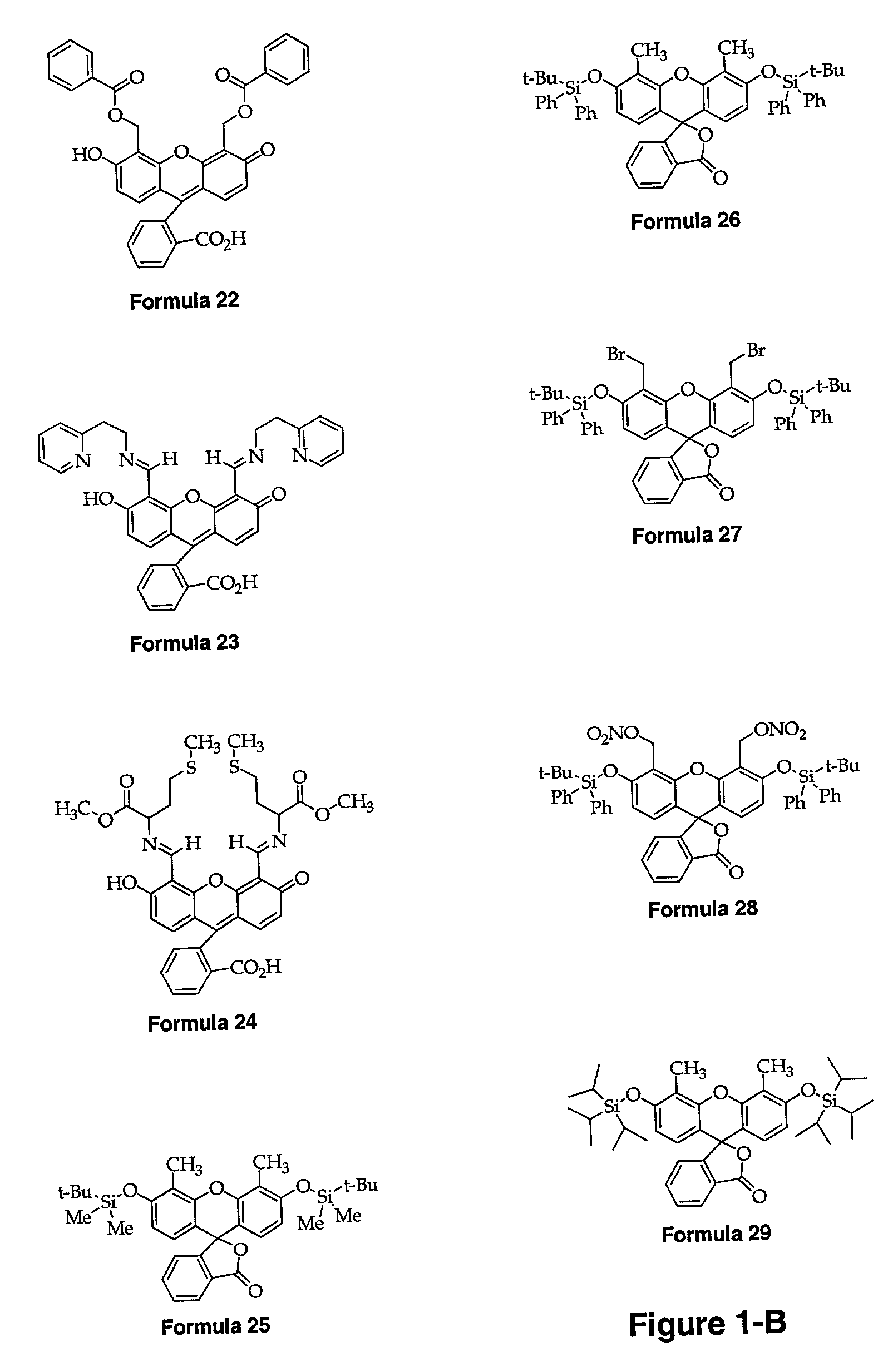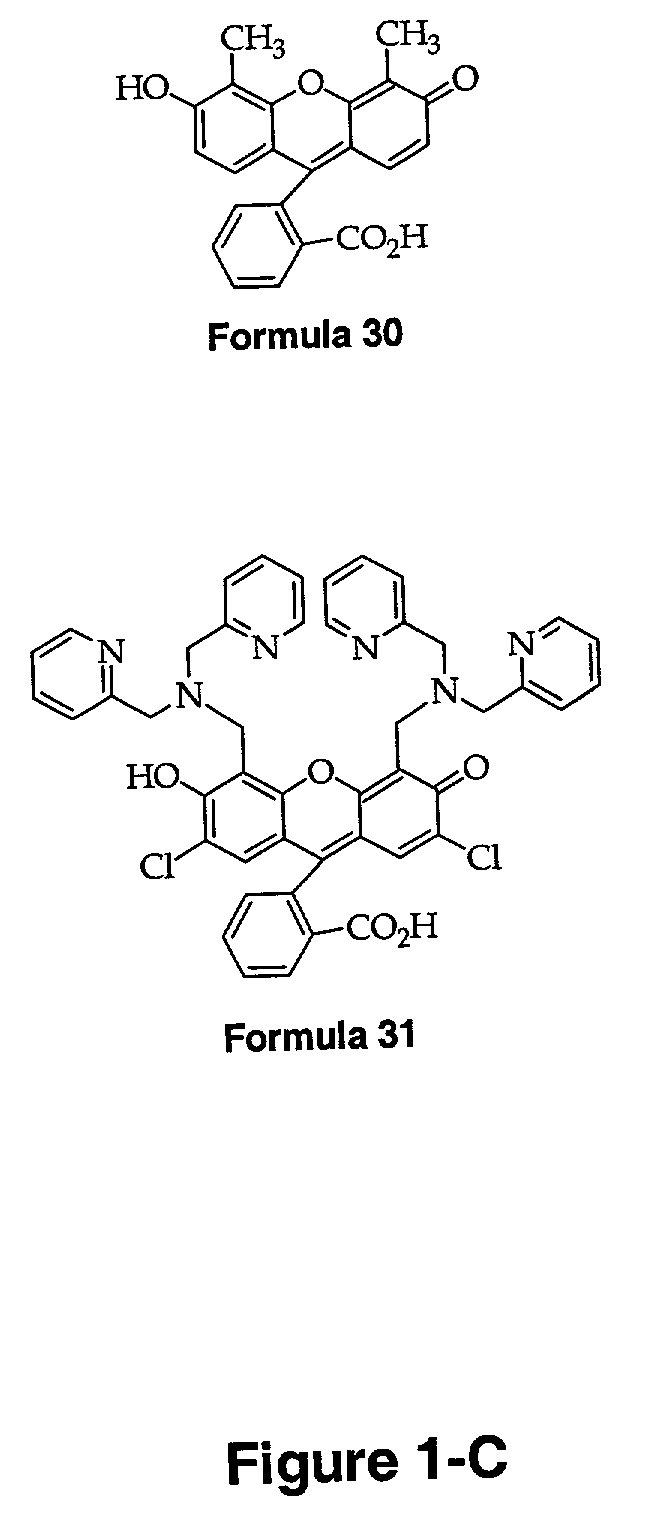Fluorescein-based metal sensors, and methods of making and using the same
a technology of fluorescein and metal sensors, applied in the field of fluorescein-based metal sensors, and methods of making and using the same, can solve the problems of toxic excess zinc ions, limited feasibility of using fluorescence technology for a particular application, and unclear znsup>2+/sup> in neurobiology
- Summary
- Abstract
- Description
- Claims
- Application Information
AI Technical Summary
Benefits of technology
Problems solved by technology
Method used
Image
Examples
example 1
[0200]Many of the following methods are described using Formula 16 in FIG. 1-A (also alternatively referred to as the ligand of Formula 16). Many of the methods are used with other subject compounds, as described below, and all of the methods may be applied to other subject compounds and ligand as well as other fluorescent compositions without undue experimentation.
a) Chemicals and Instrumentation
[0201]Chlorobenzene (C6H5Cl) and 1,2-dichloroethane (DCE) were distilled from calcium hydride (CaH2) under nitrogen. Dimethyl sulfoxide (DMSO) was vacuum distilled from CaH2 and then dried over 3 Å molecular sieves. Deuterated chloroform (CDCl3) was dried over 3 Å molecular sieves. Zinc chloride (ZnCl2) was fused prior to each use. Di(2-picolyl)amine (DPA) was prepared as previously described. All other reagents were purchased and used as received. Flash column chromatography was performed with silica gel-60 (230–400 mesh) or Brockman I activated neutral aluminum oxide (...
example 2
Synthesis of 4′,5′-Fluoresceindicarboxaldehyde
[0211]FIG. 2 shows schematically each of the following steps. Each Formula is depicted in FIG. 1-A.
[0212]a) 4′,5′-Dimethylfluorescein Dibenzoate (Formula 13) The synthesis of 4′,5′-dimethylfluorescein dibenzoate was achieved by modification of the published procedure that involves installation of benzoate protecting groups on the phenolic oxygen of 4′,5′-dimethylfluorescein. In the initial report, 4′,5′-dimethylfluorescein was prepared using benzoyl chloride and characterized only by melting point. Unprotected fluoresceins are highly polar compounds that are only slightly soluble in most common organic solvents. The benzoate protecting groups provide a convenient method for purifying fluorescein compounds by chromatography or crystallization and facilitating subsequent chemical manipulation by enhancing the their solubility in organic media. In addition, protecting the phenolic oxygens forces the fluorescein to adopt the lactoid form pre...
example 3
Synthesis of a Fluorescein-based Ligand of Formula 3 from 4′-5′-fluoresceindicarboxyaldehyde (Formula 16)
[0220]A fluorescein-based ligand of the type depicted in Formula 3 (Formula 16 in FIG. 1A) is prepared with fairly good yield by reaction of 4′,5′-fluorescein-dicarboxaldehyde with DPA using NaBH(OAc)3 as the reducing agent. The synthetic scheme for this reaction is shown as the final step of the schematic in FIG. 2. A similar method with varied amine starting materials and a fluorescein dialdehyde scaffold will be used to prepare the series of ligands depicted by Formulae 32–39 in FIG. 1-D.
[0221]4′,5′-fluorescein-dicarboxaldehyde (200 mg, 0.515 mmol) and acetic acid (120 μL, 2.1 mmol) were combined in 1,2-dichloroethane (DCE, 30 mL) and stirred. To the resulting solution DPA (215 mg, 1.08 mmol) in DCE (20 mL) was added dropwise and stirred for 30 min. Sodium triacetoxyborohydride (230 mg, 1.08 mmol) was added and the reaction mixture was stirred 12 h at room temperature. The rea...
PUM
| Property | Measurement | Unit |
|---|---|---|
| emission wavelengths | aaaaa | aaaaa |
| excitation wavelengths | aaaaa | aaaaa |
| emission wavelengths | aaaaa | aaaaa |
Abstract
Description
Claims
Application Information
 Login to View More
Login to View More - R&D
- Intellectual Property
- Life Sciences
- Materials
- Tech Scout
- Unparalleled Data Quality
- Higher Quality Content
- 60% Fewer Hallucinations
Browse by: Latest US Patents, China's latest patents, Technical Efficacy Thesaurus, Application Domain, Technology Topic, Popular Technical Reports.
© 2025 PatSnap. All rights reserved.Legal|Privacy policy|Modern Slavery Act Transparency Statement|Sitemap|About US| Contact US: help@patsnap.com



